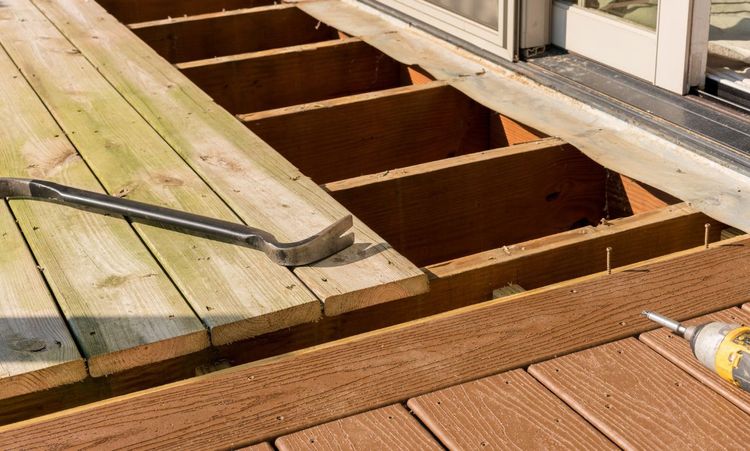Your wooden deck represents more than just outdoor space—it's where memories happen. Family barbecues, quiet morning coffees, and evening gatherings all center around this crucial part of your home. But here's the reality: wood decks demand attention to stay beautiful and safe. Most homeowners spend thousands on deck installation, yet many ignore the maintenance that protects their investment. This comprehensive guide covers everything from daily upkeep to significant repairs. You'll discover when to tackle projects and when professionals should step in. Regular maintenance saves money while extending your deck's lifespan significantly.
Replacing Damaged Boards
Deck boards take a beating from weather, foot traffic, and time. Recognizing when replacement becomes necessary prevents safety hazards and structural issues. Signs of trouble include soft spots, visible rot, or boards that flex excessively under pressure. Start by carefully removing damaged sections. Use a circular saw to cut through rotten wood, staying clear of joists underneath. Measure twice before cutting—replacement boards must fit precisely. Pressure-treated lumber works best for most climates, offering natural resistance to moisture damage. Installation requires attention to detail. Pre-drill holes to prevent splitting, especially near board ends. Use 3 1/2-inch galvanized deck screws for secure attachment. Space new boards consistently with existing ones, maintaining proper drainage gaps. A well-executed replacement blends seamlessly with surrounding deck boards.
Fixing Skirting and Fascia
Skirting and fascia boards frame your deck's perimeter, but they're often overlooked during maintenance. These components face constant moisture exposure, making them vulnerable to rot and insect damage. Regular inspections catch problems before they spread to structural elements. Water damage typically starts where the fascia meets the deck boards. Look for dark stains, softwood, or excessively peeling paint. Minor rot can be treated with a wood hardener before applying fresh stain or paint. Extensive damage requires complete board replacement. When replacing fascia, maintain proper flashing installation. This prevents water from seeping behind boards and causing hidden damage. Use a putty knife to apply exterior wood filler in small gaps. Sand smooth once dry, then apply primer before your final coat of stain or paint.
Repairing Railings and Joists
Railings provide safety, while joists support your entire deck structure. Both require different approaches but equal attention to detail. Loose railings create obvious safety hazards, while damaged joists threaten structural integrity. Check railing connections by grasping posts and pushing firmly. Any movement indicates loose fasteners or rotted mounting points. Tighten loose screws first, but replace damaged hardware with galvanized alternatives. Rotten post sections need complete replacement to ensure safety. Joist problems are more serious. Sagging deck sections often indicate compromised joists underneath. Access usually requires removing deck boards above the problem area. Sister new lumber alongside damaged joists, securing with carriage bolts every 16 inches. This method restores structural strength without complete replacement.
Essential Tools for DIY Repairs
Success depends on having the right equipment before starting any project. Basic repairs require standard carpentry tools, while significant work demands specialized equipment. Building a proper toolkit saves time and ensures professional results. Power tools make the biggest difference in efficiency. A circular saw handles most cutting tasks, while an orbital sander smooths surfaces quickly. Pressure washers clean effectively but require careful technique. Set the pressure too high, and you'll damage wood fibers permanently. Hand tools remain essential for detailed work. Keep a sharp putty knife for scraping and filling. Stiff scrub brushes remove stubborn stains without harsh chemicals. A good paint roller applies stain evenly across large surfaces. Quality brushes handle detail work around railings and tight spaces.
Knowing When to Call a Professional
DIY enthusiasm has limits, and recognizing them prevents costly mistakes. Structural repairs, electrical work, and significant renovations typically require professional expertise. Building codes and safety regulations add complexity beyond most homeowners' capabilities. Signs you need professional help include extensive rot, structural sagging, or any electrical components. Deck contractors bring specialized knowledge about local codes and proper techniques. They also carry insurance protecting you from liability during major repairs. Cost considerations factor into this decision. Simple board replacement makes sense as a DIY project. Complete deck rebuilds or structural modifications usually cost less when done professionally. Get multiple quotes before deciding, and always verify licensing and insurance.
Snow Removal Techniques
Cold weather presents unique challenges for wooden decks. Snow accumulation adds weight, while freeze-thaw cycles damage wood fibers. Proper snow removal protects your deck while preventing ice-related accidents. Use plastic shovels instead of metal ones to avoid gouging deck boards. Remove snow promptly after storms, but avoid excessive force that might damage underlying wood. Ice-melting products help, but choose carefully—some chemicals damage wood stains and sealers. Apply deck sealers before winter for additional protection. Well-sealed wood effectively sheds water, reducing freeze damage. Clear drainage paths around your deck to prevent ice buildup. Standing water creates perfect conditions for rot and structural damage.
Preventing Mold and Algae Growth
Moisture creates perfect conditions for mold and algae growth on wooden decks. These organisms not only look unsightly but can make surfaces dangerously slippery. Prevention strategies work better than removal treatments. Good air circulation prevents moisture buildup that feeds mold growth. Trim vegetation growing too close to deck surfaces. Remove outdoor furniture periodically to allow proper drying. Humid climates require extra vigilance and more frequent cleaning schedules. Cleaning solutions vary in effectiveness and environmental impact. Oxygen bleach solution works well without harsh chemicals. Mix according to package instructions and apply with a pump sprayer. Scrub with a stiff brush before rinsing thoroughly with clean water.
Advantages of Composites
Composite decking offers compelling alternatives to traditional wood. These materials combine wood fibers with synthetic polymers, creating surfaces that resist rot, insects, and fading. Understanding composite benefits helps inform replacement decisions. Composite materials significantly reduce maintenance requirements. No staining, sealing, or painting is needed—just occasional cleaning with mild soap and water. Colors remain consistent without fading, eliminating costly refinishing projects. However, composites aren't maintenance-free. They can scratch, stain, and accumulate mold in shaded areas. Initial costs run higher than pressure-treated lumber, but long-term expenses often favor composites. Consider your budget, climate, and maintenance preferences when choosing materials.
Long-term Cost Considerations
Smart deck maintenance balances upfront costs against long-term value. Regular cleaning and sealing prevent expensive repairs later. A comprehensive maintenance program costs less than major reconstructions every few years. Track maintenance expenses to understand actual ownership costs. When comparing options, include materials, tools, and your time. Professional services cost more initially but often deliver better results and longer-lasting protection. When making maintenance decisions, factor in your home's resale value. Well-maintained decks add significant value, while neglected ones become selling obstacles. Regular upkeep protects your investment while ensuring years of enjoyment.
What Maintenance Does a Wooden Deck Need?
Wooden decks require systematic care throughout the year. Spring cleaning removes winter debris and assesses damage from freeze-thaw cycles. Summer maintenance focuses on protection from UV rays and heavy use. Fall preparation readies your deck for harsh weather ahead. Annual deep cleaning forms the foundation of good maintenance. Remove all furniture and debris before washing thoroughly. Check every board for signs of damage, loose fasteners, or wear patterns. Address problems immediately before they worsen. Sealing or staining wood every 2-3 years protects it from moisture and UV damage. Choose products appropriate for your wood type and climate conditions. For best results, apply during mild weather with low humidity.
Is it Better to Pressure Wash or Clean a Deck?
Pressure washing offers quick cleaning but requires careful technique. High pressure damages wood grain and forces water deep into boards. Low pressure with proper technique cleans effectively while preserving wood integrity. Alternative cleaning methods often work better for routine maintenance. Garden hose pressure combined with deck cleaners removes most dirt and grime. Scrub brushes handle stubborn areas without forcing water into wood fibers. When done correctly, pressure washing makes sense for heavily soiled decks. Use fan tips instead of concentrated streams. Maintain consistent distance and movement to avoid streaking. Always test pressure on inconspicuous areas first.
Conclusion
Maintaining and repairing wood decks requires consistent attention but rewards owners with years of outdoor enjoyment. Regular inspections catch problems early when they're easier and cheaper to fix. Understanding when to tackle repairs yourself versus calling professionals saves money while ensuring safety. Your deck represents a significant investment in your home's value and your family's lifestyle. Protect that investment with proper maintenance techniques and quality materials. Your effort today determines how many years you'll enjoy your outdoor living space.




